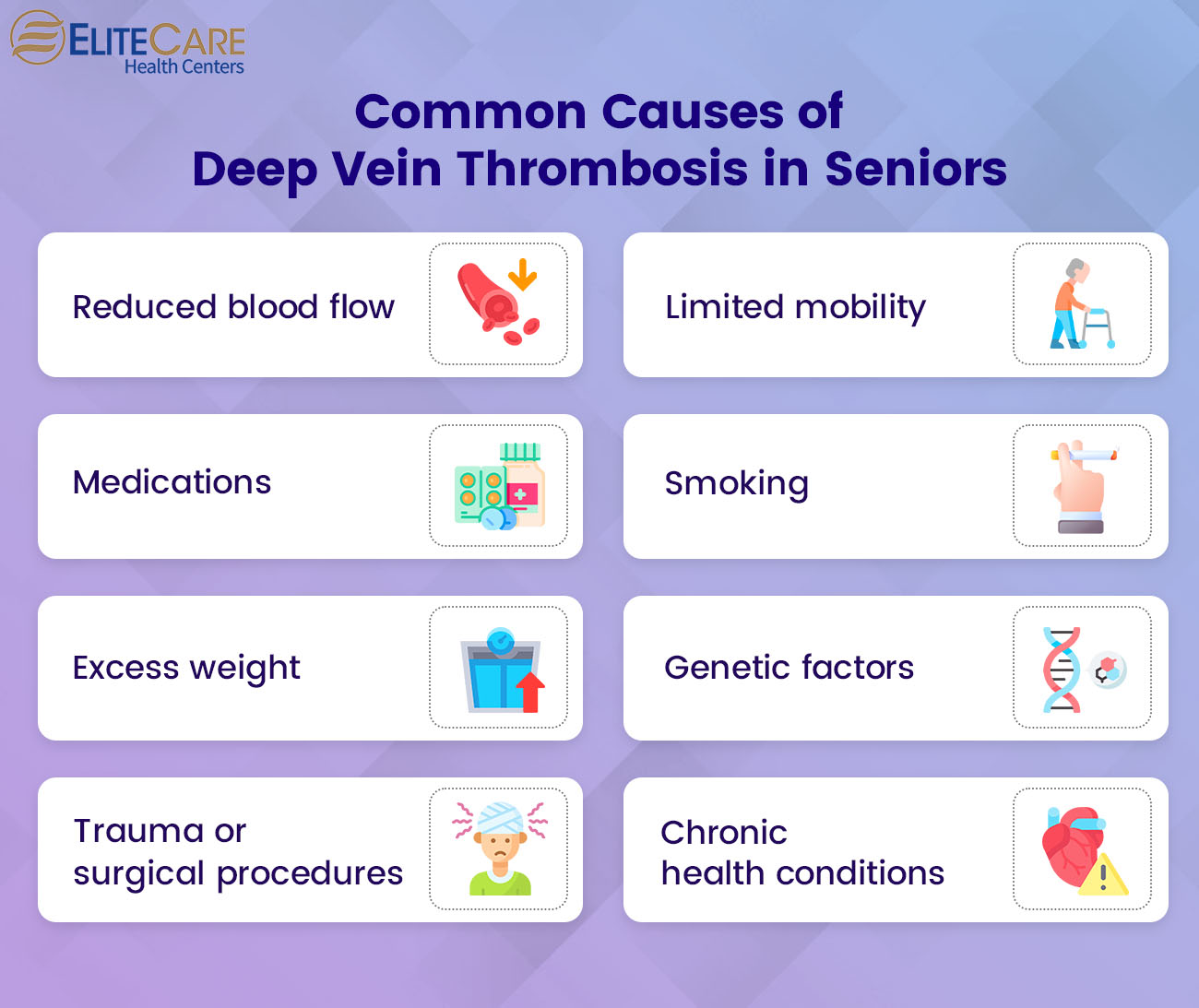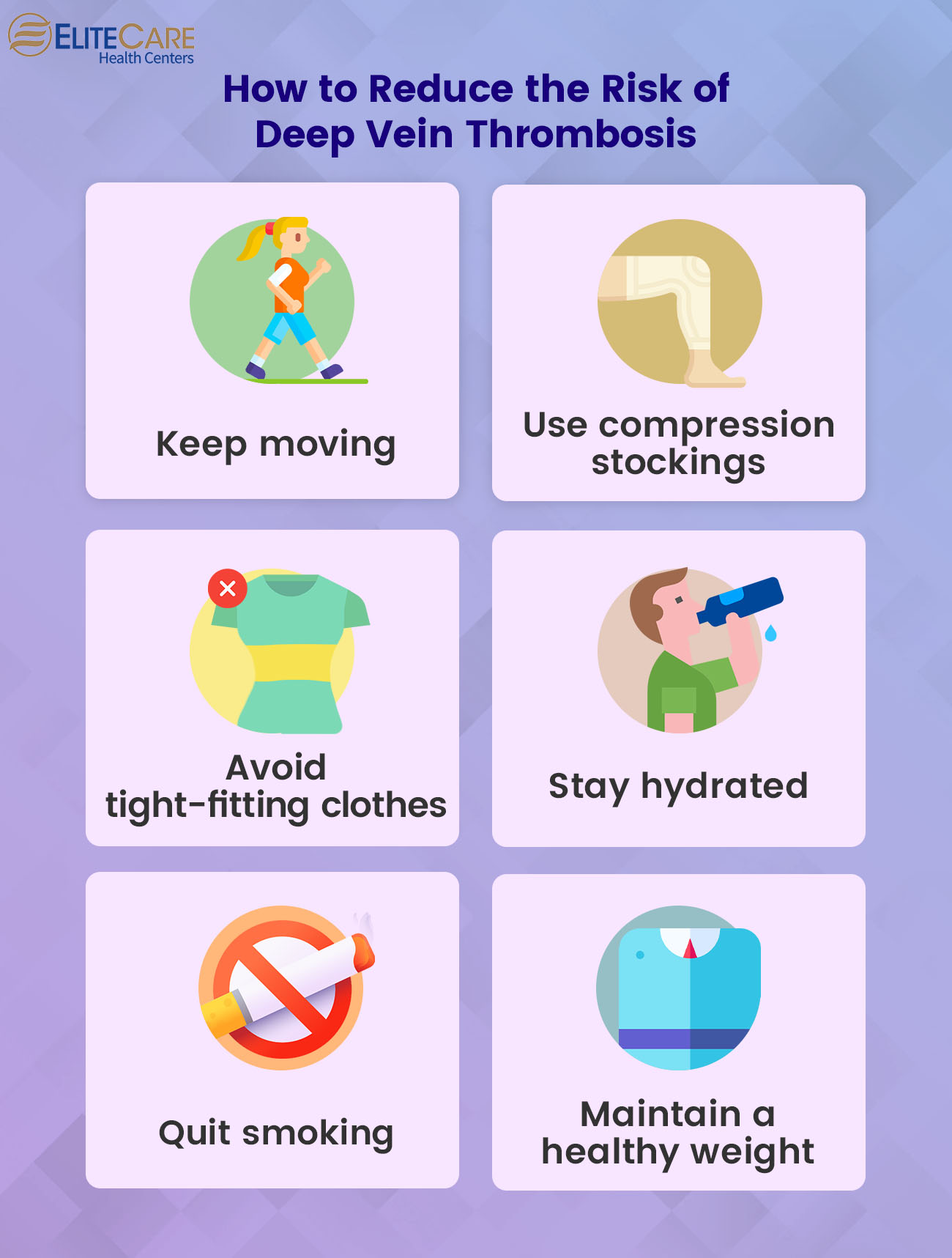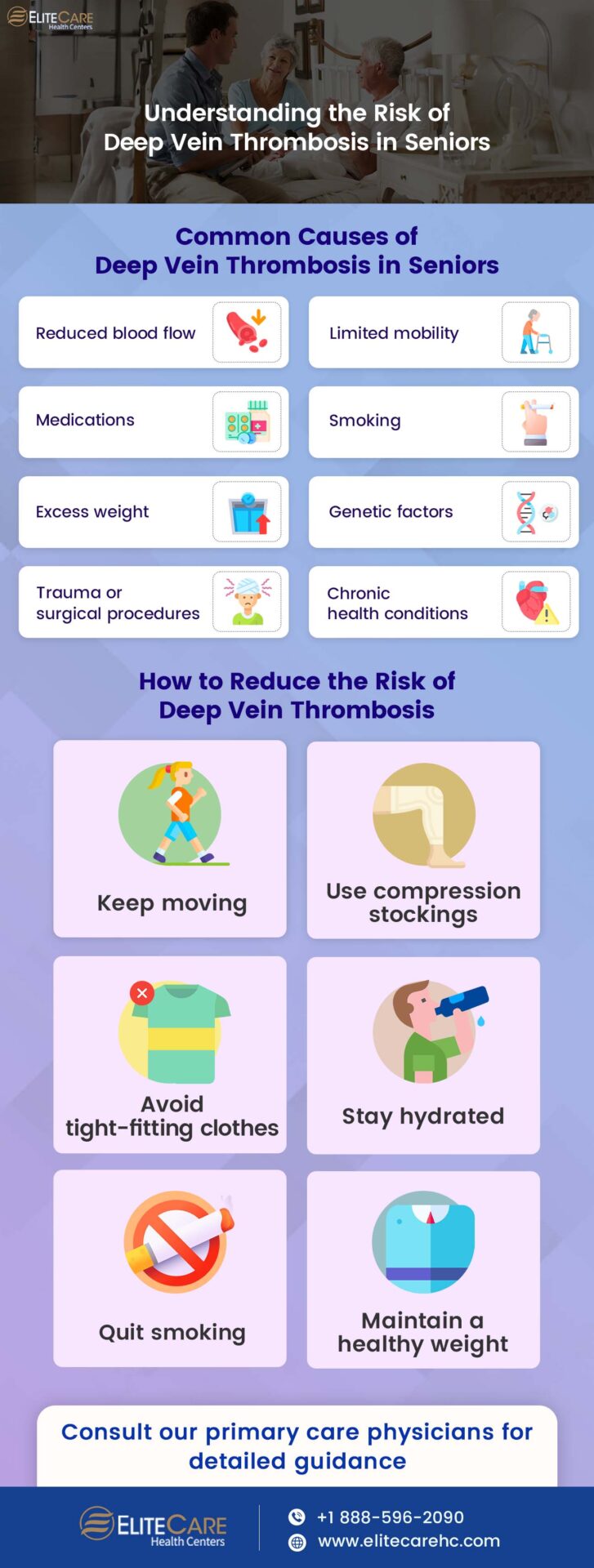
Deep vein thrombosis (DVT) is a serious medical condition affecting as many as 900,000 people in the United States every year. While it can occur at any age, seniors are particularly at an increased risk due to age-related changes and lifestyle factors.
In this blog post, we will share a comprehensive understanding of Deep vein thrombosis (DVT), including its causes, symptoms, treatment, and prevention. Read on for more.
What is Deep-Vein Thrombosis?
Also known as venous thrombosis, deep vein thrombosis (DVT) occurs when blood clots (thrombi) form in the deep veins due to vascular damage or disrupted blood flow. These clots can partially or fully obstruct blood circulation within the affected vein.
Although DVT is most common in the lower leg, thigh, or pelvis, it can also manifest in other areas such as the arm, brain, intestines, liver, or kidney.
While DVT itself isn’t immediately life-threatening, the blood clots may detach and travel through the bloodstream, leading to a pulmonary embolism (PE). A pulmonary embolism is a potentially life-threatening condition where a blood clot can disrupt blood flow to a portion of the lung. It can cause several symptoms, ranging from sudden chest pain and shortness of breath to rapid heart rate and even cardiac arrest. Pulmonary embolism requires immediate medical attention to dissolve the clot and prevent further clotting.
Are Older Adults at Greater Risk of Deep-Vein Thrombosis?

Yes, older adults are at a greater risk of developing DVT due to several reasons, which are as follows:
1. Reduced blood flow
With age, our blood vessels may lose elasticity and become more prone to damage. As a result, it can slow down the blood flow, eventually forming blood clots. Besides, our veins may also lose some of their natural strength and resilience with age, increasing the risk of clot formation.
2. Limited mobility
Due to age-related restrictions in mobility, older adults often keep their legs still for prolonged periods. When legs remain in one position for an extended period without any movement, the calf muscles fail to contract, disrupting blood flow. As a result, it can increase the risk of blood clots.
3. Trauma or surgical procedures
Seniors who have suffered a vein injury during a medical procedure or have undergone surgical interventions are at greater risk.
4. Chronic health conditions
Many older adults suffer from chronic health conditions such as heart disease, diabetes, or cancer, which can increase the risk of blood clot formation. This is because these conditions often involve inflammation and change blood composition.
In addition, conditions like Crohn’s disease or ulcerative colitis can also put a senior at an increased risk of DVT.
5. Medications
Seniors often take medications that affect blood clotting, such as hormone replacement therapy or blood-thinning medications. These medications can either increase or decrease the risk of clot formation depending on the specific medication.
6. Excess weight
Excessive body weight can put additional pressure on the pelvic and leg veins, which may cause blood clots and lead to DVT.
7. Smoking
Tobacco negatively affects blood flow and the coagulation process, therefore increasing the risk of DVT.
8. Genetic factors
Seniors with genetically mutated factor V Leiden or those who have close family members with a history of DVT should be more careful.
Commons Symptoms of Deep-Vein Thrombosis
- Swelling in the foot, ankle, or leg, confined to one side of the body
- Cramping pain in the affected leg, typically originating in the calf
- Severe and unexplained pain in the foot and ankle
- An area of skin that feels warmer
- The skin over the affected area may appear pale, reddish, or bluish
Individuals suffering from upper extremity DVT (deep vein thrombosis) or having a blood clot in the arm may not always exhibit symptoms. However, sometimes they may experience a few symptoms, which are as follows:
- Neck discomfort
- Shoulder pain
- Swelling in the arm or hand
- A change in skin color to a bluish or darker hue
- Pain that radiates from the arm to the forearm
- Weakness in the hand
Since the symptoms of DVT are not always visible, seniors often remain unaware of their DVT until they require emergency treatment for a pulmonary embolism. If caregivers or family members suspect any abnormality, consult a primary care physician for an accurate diagnosis and appropriate treatment.
Treatment Options for Deep Vein Thrombosis
DVT treatment aims to dissolve the clot, prevent any further clot, and reduce the risk of pulmonary embolism. The following are some common treatment options physicians recommend for DVT:
Medications
Doctors often prescribe blood-thinning medications, such as rivaroxaban or apixaban to prevent clot formation and reduce the impact of existing clots.
Thrombolytic drugs
For severe cases or in cases where blood thinners are ineffective, physicians prescribe thrombolytic drugs to break down clots. These are administered intravenously.
Filters
When blood thinners are unsuitable, healthcare providers may recommend a filter in the vena cava (large abdominal vein) to prevent pulmonary embolisms. However, prolonged use of filters can increase DVT risk.
Surgery
Healthcare professionals opt for surgical clot removal or thrombectomy only for extensive or problematic clots. This surgical procedure comes with additional risks, including infection, vessel damage, and excessive bleeding.
How to Reduce the Risk of Deep-Vein Thrombosis

1. Keep moving
Seniors should take a walk or stretch at least once every hour to avoid prolonged periods of immobility. Whether it is a long flight journey or watching TV, always take breaks to stretch and move both the upper and lower extremities.
Caregivers or family members should consult a primary care physician or an expert trainer to incorporate leg exercises into their routine to promote circulation. Along with gentle leg exercises, seniors can go walking, cycling, and swimming.
2. Use compression stockings
Primary care physicians recommend the daily use of compression stockings below or just above the knee for those at high risk of DVT. These stockings can help reduce swelling and clot development.
3. Choose comfortable clothing
Avoid tight-fitting clothes that constrict blood flow, especially around the waist, thighs, and calves. Wear loose-fitting attire to encourage healthy blood circulation.
4. Maintain a healthy weight
Excess weight can increase pressure on the veins in the pelvis and legs. Eat a balanced diet and exercise regularly to reduce the strain on the circulatory system. Consult a registered dietitian for personalized dietary recommendations.
5. Stay hydrated
Proper hydration is essential for maintaining healthy blood viscosity and circulation. Since seniors sometimes lack thirst sensation, it is crucial to remind them to drink water throughout the day. Make sure to increase their water intake if they are in a dry or warm environment.
6. Quit smoking
Smoking can negatively impact blood flow and clotting, making seniors more susceptible to DVT. Consult a primary care physician for detailed guidance and resources on quitting smoking.
Seniors should always consult a healthcare professional for personalized advice and risk assessment.
The Bottom Line
Seniors as well as their caregivers should never overlook the symptoms of DVT because immediate medical attention can potentially prevent the onset of a life-threatening pulmonary embolism. Approximately 33% of individuals who have experienced DVT or PE are at risk of experiencing a recurrence within a 10-year period. It is crucial to take preventive measures along with prescribed medications to prevent recurrence. An active lifestyle is a key component of DVT prevention. Therefore, caregivers should encourage seniors to stay active as much as their body permits.
For any further queries or concerns over deep vein thrombosis, contact EliteCare Health Centers and consult a board-certified primary care physician. We are one of the best medical clinics in Florida that offers a wide range of senior care services, including venipuncture, preventive care, annual physical exams, etc. Schedule an appointment at your nearest healthcare center now!






